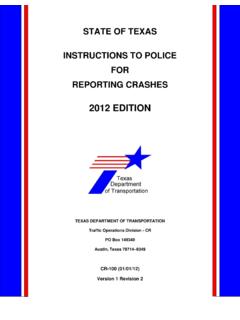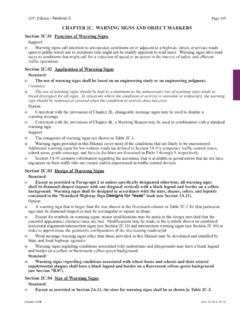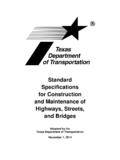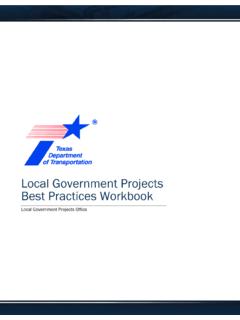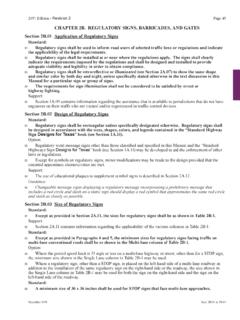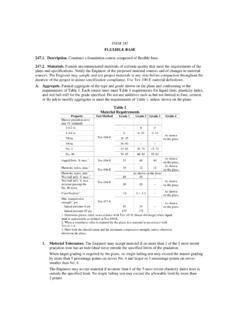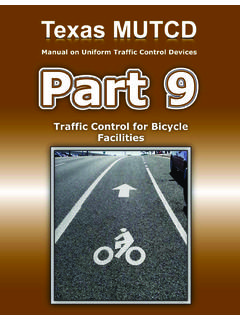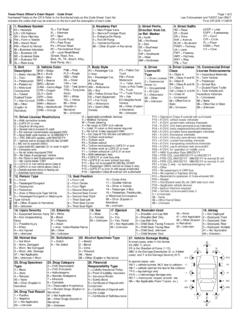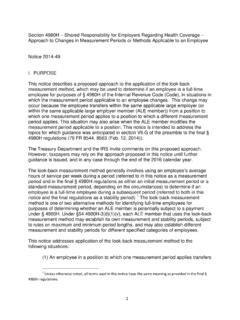Transcription of What is ESAL?
1 What is ESAL? ESAL is the acronym for equivalent single axle load. ESAL is a concept developed from datacollected at the American Association of State Highway Officials (AASHO) Road Test toestablish a damage relationship for comparing the effects of axles carrying different reference axle load is an 18,000-lb. single axle with dual is design ESALs?Design ESALs is a cumulative traffic load summary statistic. The statistic represents a mixedstream of traffic of different axle loads and axle configurations predicted over the design oranalysis period and then converted into an equivalent number of 18,000-lb. single axle loadssummed over that the following calculations to determine design ESALs:Where:Tf= truck factorUse the following calculation to determine Tf:Where:pi= percentage of total repetitions for the ith load groupFi= equivalent axle load factor for the ith load groupA = average number of axles per = percentage of trucks in average daily traffic (ADT)G = growth factorUse the following calculation to determine G:Where:g = annual growth raten = analysis period in yearsD = directional distribution factorL = lane distribution factorY = design period in yearsFor more information, refer to Appendix D of AASHTO Guide for Design of PavementStructures(1993).
2 Published Quarterlyby the Constructionand Bridge DivisionsThird Quarter2005 Flexible PavementDesign FrequentlyAsked Questions_____TEXAS DEPARTMENT OF TRANSPORTATION(365)fESALsT TGDLY =1== mfiiiTpFA( ( )()11ngGg+ =When can I use a lane distribution factor?Lane distribution factors are used to reduce the estimated one-direction cumulative ESALs for sections that have three or morelanes in one direction. For these sections, truck traffic will tend to use the inner lanes more often than the two-lane scenario,thus reducing the accumulation of loads on any one lane. The following distribution factors can be used as a multiplier to theone-direction cumulative ESALs to establish the design traffic:3 or more do I get the ESAL information?Transportation Planning and Programming Division (TP&P), Traffic Analysis Section provides beginning and ending two-direction average daily traffic (ADT) statistics for the beginning and ending year of the analysis period, directional distribution,percentage trucks in the ADT, the average ten heaviest wheel loads daily (ATHWLD) statistic, the percent tandem axles in theATHWLD, and one-direction cumulative ESALs for both flexible and rigid pavement design.)
3 Further summary statistics areprovided for the percent trucks in terms of percent medium duty and heavy request for a traffic study should include the following information: geographic limits base year and design year for the project (base year should be tied to the projected opening date to traffic) current land use maps for the area surrounding the proposed project location and type of major traffic generators past and current traffic counts for an existing facility major cross streets map giving general project alignment identification of proposed facility type one or two way operation number of lanes (for facilities with frontage roads, the designer should also specify requirements for mainlanes andfrontage roads separately) preliminary schematic or straight-line map length (in ft.) for each link of the proposed facility (new location projects only).
4 Requests for traffic projections should be coordinated with the District Director of Transportation Planning & Development(TP&D).For more information, refer to 1430: Obtain Traffic Data in the Project Development Process traffic data should I use if my analysis period is not 20years?You must always input the 20-year cumulative one-direction ESALs in FPS-19 (Texas Flexible Pavement Design System). Notethat ESALs stated in the traffic report are cumulative one-direction ESALs. If you want to consider an analysis period other than20 years, adjust the analysis period input accordingly. The program will automatically calculate the appropriate cumulativeESALs and ending ADT for the new analysis is the computer program that I can use for flexiblepavement design?For flexible pavement designs, FPS-19W (Texas Flexible Pavement Design System [Windows]) or AASHTO Design Procedure,DARWin , may be used.
5 FPS-19W is the preferred and Materials TipsThird Quarter, 2005 What back-calculated layer moduli should I expect whenrunning the MODULUS program?Falling weight deflectometer (FWD) deflection data and accurate pavement layer thickness data must be processed throughMODULUS to provide back-calculated layer similar to the one presented in Table 1 should be expected for layer layer moduli should I use for designing a flexiblepavement?For existing pavements, FWD deflection data and accurate pavement layer thickness data must be processed throughMODULUS to provide back-calculated layer moduli. Back-calculated layer moduli are needed for a new construction, the recommended values shown in Table 2 may be and Materials TipsThird Quarter, 2005 Table 1. Typical Back-Calculated Values for Moduli of Pavement LayersElastic Modulus, (ksi) MaterialGoodFairPoorDense-Graded Hot Mix Asphalt Concrete (HMAC)1500 Performance Design HMAC1650 - 800 Flexible Base2755025 Cement Stabilized Base 35015075 Lime Stabilized Base 75-20040-75less than 40 Cement Stabilized Subgrade 50 Lime Stabilized Subgrade 50 Subgrade Soils 12-168-124-81 HMAC is a visco-elastic material; the modulus is temperature sensitive and will vary according to thetemperature at the time of testing.
6 2 The flexible base modulus will vary depending on the quality of the material (toughness, particleangularity, percent fines - especially clayey fines), the overall thickness, and the support provided bythe subgrade. Table 2. Typical Design Values for Moduli of Pavement Layers MaterialElastic Modulus, (ksi) Dense-Graded HMAC 500 Performance HMAC 650 - 800 Flexible Base140-70 Cement Stabilized Base2120-150 Lime Stabilized Base260-75 Cement Stabilized Subgrade335-45 Lime Stabilized Subgrade335-45 Subgrade Soils 12-41 The flexible base modulus will vary depending on the quality of the material (toughness, particle angularity, percent fines - especially clayey fines), the overall thickness, and the support provided by the lime and cement stabilized base material, the current version of FPS-19 will likely under-design the structure for modulus values > 250 ksi.
7 Minimum thickness of 8 in. Also, laboratory evaluation of the proposed material should be made to insure a target unconfined compressive strength of 300 psi is attained, with 85% of this strength retained after 10-day capillary rise. Over-stabilization is not encouraged as it may lead to shrinkage cracking, reflecting through the surface. 3 Lime or cement series should be run to insure optimal stabilizer type and content is sophisticated techniques, both destructive and non-destructive, are available to determine valuable pavement layerinformation. These techniques are not common practice but may be discussed with CST/M&P design type should I use when designing with FPS-19W?Use the design type appropriate for the proposed structure:Type 1- HMAC over flexible base on subgrade. This option should be used when no stabilized layers are anticipated, includingwhen a minimum amount of stabilizer is used in the prepared subgrade to function as a working surface.
8 This design type willtie the base modulus to the subgrade modulus using an algorithm that includes the effect of support offered by the , based on engineering judgment, the designer may override the calculated base modulus. This option can also beused to design two course surface treatments on top of a flexible base or on top of a light stabilized 2- HMAC over asphalt stabilized base on subgrade. This option should be used for full-depth bituminous structures onnon-stabilized 3- HMAC over asphalt stabilized base on flexible base on subgrade. This option can be used as presented, or othermaterials such as stabilized subgrade or another bituminous layer may be substituted for the flexible base layer. If used asstated, the flexible base modulus will be tied to the subgrade modulus using an internal 4- HMAC over flexible base over stabilized subgrade over subgrade.
9 This option can be used as stated or for HMAC orsurface treatments over light stabilized bases over stabilized subgrade over 5- HMAC overlay on an existing flexible structure. Use this option to design a structural overlay. The thickness of allexisting layers must be fixed at the maximum thickness of each layer. This design type is not to be used for design of HMAC overlay on an existing rigid are many situations in which the existing or desired number of distinct structural layers exceeds the layers allowed by theabove options. When this is the case, layers may be consolidated or ignored to allow use of the software. Consolidation shouldbe considered for materials with similar stiffness properties only. Considerations for determining the governing layer should bebased on which layer contributes the most to the overall depth to bedrock should I use?
10 The depth to bedrock that is computed in the MODULUS program should also be used in the FPS design. Alternatively, if noother information is available, the default values in FPS may be used. Which generated design should I use? (in case of severaloutputs from FPS-19W)In case of several outputs from FPS-19W, each design should be evaluated by using the Design Check option of the selected designs must be checked using the Modified Texas Triaxial Check (referenced in the TTI Report 1869-2).The following guidelines should be considered when selecting the best design: The design shouldpass the Texas Triaxial Design Check. Engineering judgment can be used as justification to overridethe outcome of this check if performance of similar structures (under similar traffic, subgrade, etc.) in the district haveproven viable. constructability of proposed materials at the suggested layer thickness compatibility with the existing structure (widening), including considerations for positive (internal) drainage number of performance periods - minimum initial performance period of eight years before an overlay is required performance time life cycle cost as well as initial (capital) costs - inputs such as traffic information, layer information, detour, etc.

